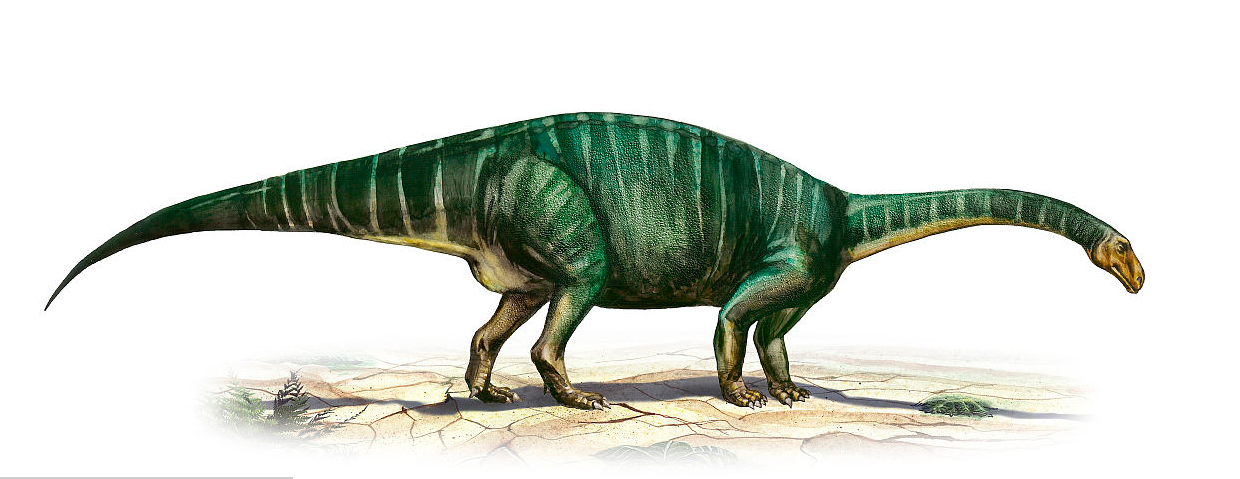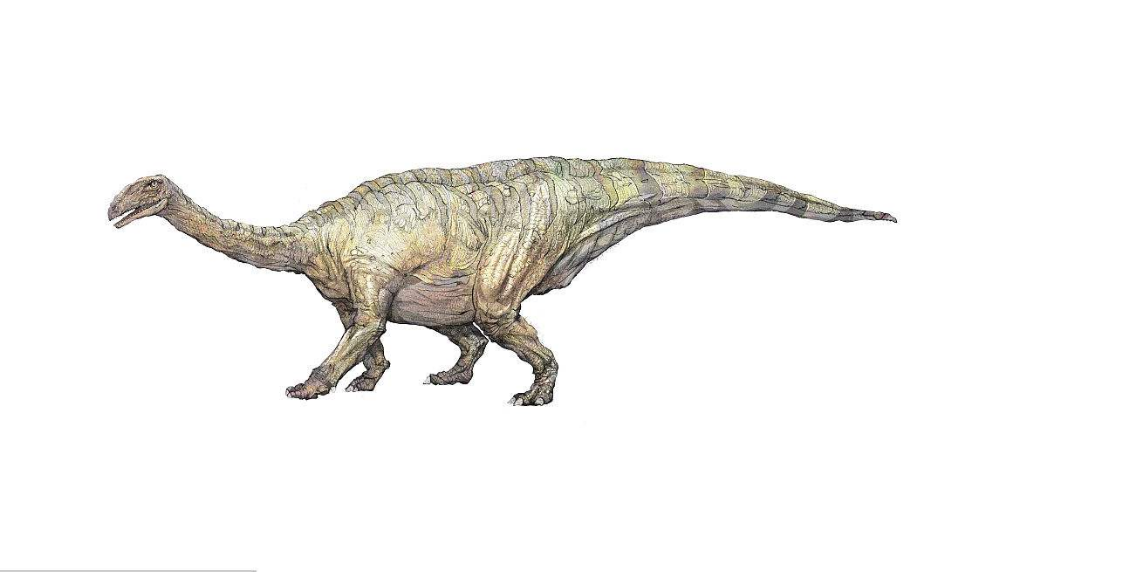Dinosaur Knowledge Tips Plateosaurus
Release time:2018/4/10 9:39:00

Plateosaurus (probably meaning "broad lizard", often mistranslated as "flat lizard") is a genus of plateosaurid dinosaur that lived during the Late Triassic period, around 214 to 204 million years ago, in what is now Central and Northern Europe. Plateosaurus is a basal (early) sauropodomorph dinosaur, a so-called "prosauropod". As of 2011, two species are recognized: the type species P. engelhardti from the late Norian and Rhaetian, and the slightly earlier P. gracilis from the lower Norian. However, others have been assigned in the past, and there is no broad consensus on the species taxonomy of plateosaurid dinosaurs. Similarly, there are a plethora of synonyms (invalid duplicate names) at the genus level.
Discovered in 1834 by Johann Friedrich Engelhardt and described three years later by Hermann von Meyer, Plateosaurus was the fifth named dinosaur genus that is still considered valid. Although it had been described before Richard Owen formally named Dinosauria in 1842, it was not one of the three genera used by Owen to define the group, because at the time, it was poorly known and difficult to identify as a dinosaur. It is now among the dinosaurs best known to science: over 100 skeletons have been found, some of them nearly complete. The abundance of its fossils in Swabia, Germany, has led to the nickname Schwäbischer Lindwurm (Swabian lindworm).
Plateosaurus was a bipedal herbivore with a small skull on a long, flexible neck, sharp but plump plant-crushing teeth, powerful hind limbs, short but muscular arms and grasping hands with large claws on three fingers, possibly used for defence and feeding. Unusually for a dinosaur, Plateosaurus showed strong developmental plasticity: instead of having a fairly uniform adult size, fully grown individuals were between 4.8 and 10 metres (16 and 33 ft) long and weighed between 600 and 4,000 kilograms (1,300 and 8,800 lb). Commonly, the animals lived for at least 12 to 20 years, but the maximum life span is not known.
Despite the great quantity and excellent quality of the fossil material, Plateosaurus was for a long time one of the most misunderstood dinosaurs. Some researchers proposed theories that were later shown to conflict with geological and palaeontological evidence, but have become the paradigm of public opinion. Since 1980 the taxonomy (relationships), taphonomy (how the animals became embedded and fossilized), biomechanics (how their skeletons worked), and palaeobiology (life circumstances) of Plateosaurus have been re-studied in detail, altering the interpretation of the animal's biology, posture and behaviour.

Plateosaurus had the typical body shape of a herbivorous bipedal dinosaur: a small skull, a long and flexible neck composed of 10 cervical vertebrae, a stocky body, and a long, mobile tail composed of at least 40 caudal vertebrae. The arms of Plateosaurus were very short, even compared to most other "prosauropods". However, they were strongly built, with hands adapted for powerful grasping. The shoulder girdle was narrow (often misaligned in skeletal mounts and drawings), with the clavicles (collar bones) touching at the body's midline, as in other basal sauropodomorphs. The hind limbs were held under the body, with slightly flexed knees and ankles, and the foot was digitigrade, meaning the animal walked on its toes. The proportionally long lower leg and metatarsus show that Plateosaurus could run quickly on its hind limbs.[ The tail of Plateosaurus was typically dinosaurian, muscular and with high mobility.
The skull of Plateosaurus is small and narrow, rectangular in side view, and nearly three times as long as it is high. There is an almost rectangular lateral temporal foramen at the back. The large, round orbit (eye socket), the sub-triangular antorbital fenestra and the oval naris (nostril) are of almost equal size. The jaws carried many small, leaf-shaped, socketed teeth: 5 to 6 per premaxilla, 24 to 30 per maxilla, and 21 to 28 per dentary (lower jaw). The thick, leaf-shaped, bluntly serrated tooth crowns were suitable for crushing plant material. The low position of the jaw joint gave the chewing muscles great leverage, so that Plateosaurus could deliver a powerful bite.[8] These features suggest that it fed primarily to exclusively on plants. Its eyes were directed to the sides, rather than the front, providing all-round vision to watch for predators. Some fossil skeletons have preserved sclerotic rings (rings of bone plates that protect the eye).
The ribs were connected to the dorsal (trunk) vertebrae with two joints, acting together as a simple hinge joint, which has allowed researchers to reconstruct the inhaled and exhaled positions of the ribcage. The difference in volume between these two positions defines the air exchange volume (the amount of air moved with each breath), determined to be approximately 20 L for a P. engelhardti individual estimated to have weighed 690 kg, or 29 mL/kg bodyweight. This is a typical value for birds, but not for mammals, and indicates that Plateosaurus probably had an avian-style flow-through lung, although indicators for postcranial pneumaticity (air sacs of the lung invading the bones to reduce weight) can be found on the bones of only a few individuals, and were only recognized in 2010. Combined with evidence from bone histology this indicates that Plateosaurus was endothermic.
The type species of Plateosaurus is P. engelhardti. Adults of this species reached 4.8 to 10 metres (16 to 33 ft) in length, and ranged in mass from 600 to 4,000 kilograms (1,300 to 8,800 lb). The geologically older species, P. gracilis (formerly named Sellosaurus gracilis), was somewhat smaller, with a total length of 4 to 5 metres (13 to 16 ft).

In 1834, physician Johann Friedrich Engelhardt discovered some vertebrae and leg bones at Heroldsberg near Nuremberg, Germany. Three years later German palaeontologist Hermann von Meyer designated them as the type specimen of a new genus, Plateosaurus. Since then, remains of well over 100 individuals of Plateosaurus have been discovered at various locations throughout Europe.
Material assigned to Plateosaurus has been found at over 50 localities in Germany (mainly along the Neckar and Pegnitz river valleys), Switzerland (Frick) and France Three localities are of special importance, because they yielded specimens in large numbers and of unusually good quality: near Halberstadt in Saxony-Anhalt, Germany; Trossingen in Baden-Württemberg, Germany; and Frick. Between the 1910s and 1930s, excavations in a clay pit in Saxony-Anhalt revealed between 39 and 50 skeletons that belonged to Plateosaurus, along with teeth and a small number of bones of the theropod Liliensternus, and two skeletons and some fragments of the turtle Proganochelys. Some of the plateosaur material was assigned to P. longiceps, a species described by palaeontologist Otto Jaekel in 1914 but now considered a junior synonym of P. engelhardti. Most of the material found its way to the Museum für Naturkunde in Berlin, where much of it was destroyed during World War II. The Halberstadt quarry today is covered by a housing development.
The second major German locality with P. engelhardti finds, a quarry in Trossingen in the Black Forest, was worked repeatedly in the 20th century. Between 1911 and 1932, excavations during six field seasons led by German palaeontologists Eberhard Fraas (1911–1912), Friedrich von Huene (1921–23), and finally Reinhold Seemann (1932) revealed a total of 35 complete or partially complete skeletons of Plateosaurus, as well as fragmentary remains of approximately 70 more individuals. The large number of specimens from Swabia had already caused German palaeontologist Friedrich August von Quenstedt to nickname the animal Schwäbischer Lindwurm (Swabian lindworm or Swabian dragon).[B] Much of the Trossingen material was destroyed in 1944, when the Naturaliensammlung in Stuttgart (predecessor to the State Museum of Natural History Stuttgart (SMNS)) burnt to the ground after an Allied bombing raid. Luckily, however, a 2011 study by SMNS curator Rainer Schoch found that, at least from the finds of Seemann's 1932 excavation, "the scientifically most valuable material is still available".
The Plateosaurus skeletons in a clay pit of the Tonwerke Keller AG in Frick, Switzerland, were first noticed in 1976. While the bones are often significantly deformed by taphonomic processes, Frick yields skeletons of P. engelhardti comparable in completeness and position to those of Trossingen and Halberstadt.
In 1997, workers of an oil platform of the Snorre oil field, located at the northern end of the North Sea, were drilling through sandstone for oil exploration when they stumbled on a fossil they believed to be plant material. The drill core containing the fossil was extracted from 2,256 metres (7,402 ft) below the seafloor. Martin Sander and Nicole Klein, palaeontologists of the University of Bonn, analysed the bone microstructure and concluded that the rock preserved fibrous bone tissue from a fragment of a limb bone belonging to Plateosaurus, making it the first dinosaur found in Norway. Plateosaurus material has also been found in the Fleming Fjord Formation of East Greenland.
Plateosaurus gracilis, the older species, is found in the Löwenstein Formation (Lower Norian). P. engelhardti stems from the upper Löwenstein Formation (Upper Norian), the Trossingen Formation (Upper Norian), and equivalently aged rock units. Plateosaurus thus lived probably from approximately 214 to 204 million years ago.
from Wikipedia